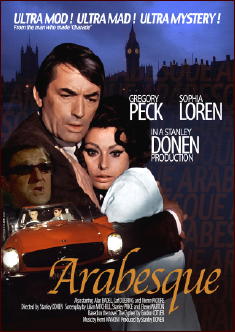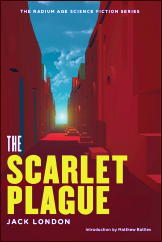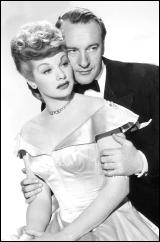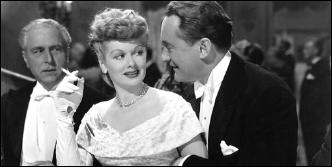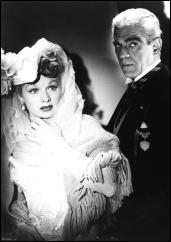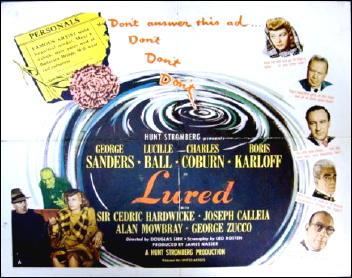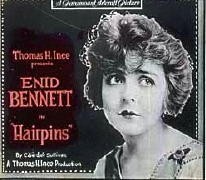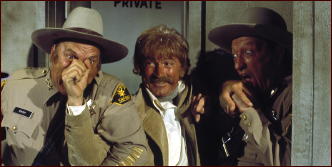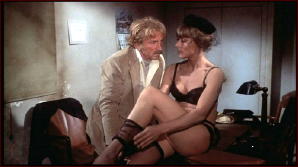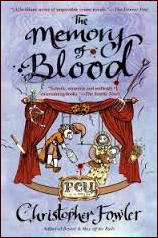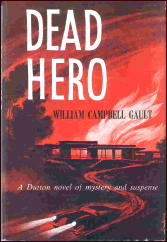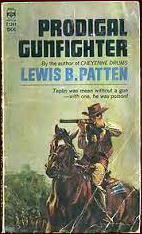Sun 16 Mar 2014
A Book/Movie Review by Dan Stumpf: ALEX GORDON – The Cipher / ARABESQUE (1966).
Posted by Steve under Reviews , Suspense & espionage films[7] Comments
ALEX GORDON – The Cipher. Simon & Schuster, hardcover, 1961. Grove Press, paperback, 1961. Pyramid X-1483, paperback, 1966.
ARABESQUE. Universal, 1966. Gregory Peck, Sophia Loren, with Alan Badel, Kieron Moore, Carl Duering, John Merivale, Duncan Lamont, George Coulouris. Based on the book The Cipher, by Alex Gordon. Director: Stanley Donen.
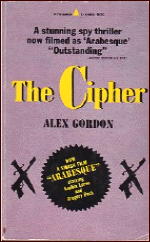
Alex Gordon’s The Cipher is a polite little mystery that tiptoes into Graham Greene country now and again on its gentle way to wherever it’s going.
Philip Hoag carries the tale, a reedy, asthmatic professor of middle-eastern anthropology, bullied by his superiors at college, handymen in his apartment building, and lately deserted by his wife and child — the sort of burnt-out case Greene evoked so well, here trotted out to play an unlikely part in a scheme of international intrigue and all that sort of thing.
Hoag finds himself suborned by a corpulent Arabian tycoon named Beshraavi (who could as easily been called Sydney Greenstreet) to decipher an inscription that Beshraavi may have murdered to get. The money’s good and Hoag is easy to push around, so he soon finds himself working on it—and just as quickly finds himself warned by Beshraavi’s perky little college-girl niece that finishing the job will almost certainly prove hazardous to his health.
We turn another couple of pages and Hoag is running for his life, trying to escape the Arab’s minions, prevent an assassination and protect his own wife and child.
Given this premise, it’s surprising how little action there actually is in The Cipher, as Hoag spends most of the book trying to figure out the people involved and maneuver his way around and through a web of tangled motivations and petty personal problems.
I think I know what author Gordon was trying to do though: As Hoag moves through various strata of society and begins to understand the personalities involved, he grows increasingly adept at persuading, manipulating and even bullying on his own part, and The Cipher becomes less an action story and more about the growth of his character.
And if Gordon never quite achieves the heights of Graham Greene or Eric Ambler, one has to give him marks for trying and note that the last few chapters generate some real suspense, capped off with a genuinely amusing curtain line.
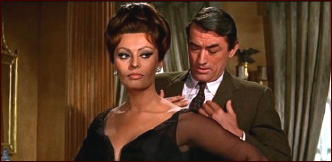
When this was turned into a movie, they credited Gordon under his real name (Gordon Cotler, a busy screenwriter in his day) and changed the title to Arabesque, but this was only the beginning of the cheerful havoc wreaked on The Cipher by director Stanley Donen and a phalanx of writers that included Peter (Charade) Stone. To play the book’s frail asthmatic professor with thinning blonde hair, Donen naturally turned to Gregory Peck, who transforms the character into that staple of the Movies: a healthy, handsome, straight guy with no visible neuroses who has somehow grown into early middle age without ever getting married.
The gluttonous Arab is played by slender British actor Alan Badel (who infuses the part with a genial, easy-going nastiness, coupled with a neat touch of fetishism) and the perky little niece becomes Sophia Loren, a fine actress but one to whom the words “perky†and especially “little†simply do not apply.
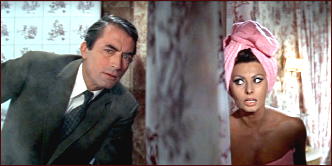
With this as a start, Donen and his crew proceed to run through Gordon’s gentle book with a mulching mower, filling the movie with witty quips, furious fight scenes and hairbreadth escapes reminiscent of the old serials while cinematographer Christopher Challis (best remembered for Tales of Hoffman) shoots everything at odd camera angles, through chandeliers, from inside fish tanks, reflected in mirrors or from underneath rugs, giving the film a baroque look that more than justifies the title.
Somewhere in all this is a story about a cipher to be decoded, a planned assassination and a few other bits and pieces from Gordon’s book that pop up from time to time like frightened squirrels looking fearfully about the turbulent surroundings, ready to flee at once. But it’s all so much fun and (like Loren herself) so easy to look at that one easily forgives the excesses to relax and enjoy a simple fun movie.
